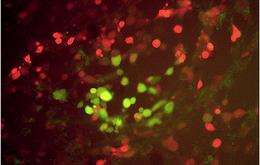Yale Scientists Shed Colorful Light On Novel Proteins

(PhysOrg.com) -- A Yale School of Medicine neuroscientist investigating how viruses can be used to attack brain cancers has developed a new method to generate novel, color-coded proteins that can be used by researchers investigating cures for a host of diseases.
A Yale School of Medicine neuroscientist investigating how viruses can be used to attack brain cancers has developed a new method to generate novel, color-coded proteins that can be used by researchers investigating cures for a host of diseases.
Anthony N. van den Pol, professor of neurosurgery and member of the Yale Cancer Center and molecular biologist John N. Davis describe the new technique in the February issue of the Journal of Virology.
The two researchers show how to use a mutation-prone virus engineered to express fluorescent proteins in order to generate new proteins of interest to scientists. This virus not only generates mutated genes that code for these proteins but also can express them within cells so scientists can study their function.
The procedure has the potential to streamline research to identify and study novel mutant proteins, van den Pol said.
Instead of trying to generate novel proteins from gene mutants within hundreds of thousand of bacteria colonies, “we can find them under the microscope in five minutes because altered fluorescent proteins are of different colors,” he said.
Van den Pol’s lab has developed viruses that selectively attack and kill cancer cells. Previously, scientists have had to stop experiments at different intervals to measure the effects of different agents on tumors. The use of proteins that show different color fluorescence allows scientists to simultaneously view - in culture dishes or mice - cancer killing viruses that express one color and live cancer cells that express a different color.
“Many scientists at Yale now use fluorescent proteins to study mechanisms of replication, migration, and differentiation in normal and cancer cells. The potential for rapidly generating novel mutant fluorescent proteins may help in these endeavors,” van den Pol said.















